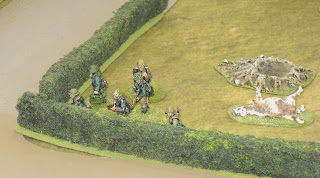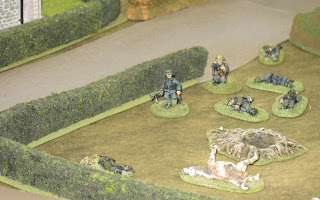...but this time I was Austrian. :o)
Simon arrived this morning, and given the choice, opted for the Bavarians, so this time I would be Austrian. The rules were a modified / simplified version of Brigadier Peter Young's 'Charge!'.
The first thing we did was to number our units as we would want them from left to right before rearranging them that way. This pre-game tweak was to allow us to shuffle our units around, within the same constrained deployment area, if we weren't happy with how I had plonked them down when setting up the table.
We both made some changes, first my Austrians, from [their] left to right: the Hungarian Andrássy Infantry Regiment (IR); the Batthyányi Dragoon Regiment (DR); the Los Rios IR; a Field Artillery battery; the Arberg IR; the Baranyáy Hussar Regiment (HR); and, the Karlstadt Pandurs (Croats). Out in front is Khevenhüller and his staff.
Now, the Bavarians from [their] right to left: the Frangipani HR (yes that's a real regiment); a Field Artillery battery; The Pfalz Zweibrücken IR; the Max Josef IR; the Swiss Diesbach von Signau IR; the Hohenzollern DR; and, the von der Kurz Frei Korps. And, these were all being led into the field by von Seckendorff and his coterie of staff officers.
Turn 1: and we got down to the serious business of writing orders for all our units. Every unit starts the game with an order but in future turns the commanders can only write as many new orders per turn as they have ADCs. Therefore, orders should be specific about whether it's just for the current move, or to be followed until a new order arrives. Both sides' move, shoot and mêlée simultaneously.
My plan was to occupy my objective, the town of Ytterberg, and stand on the defensive until it was clear what reinforcements would arrive in Turn 5. This got underway with the Andrássy IR stepping off into column to wend its way into Ytterberg to occupy the buildings along the far side; this was why I had repositioned them to be on the left of my line. My guns moved forward to form a battery behind the hedge with my infantry ordered to form line either side of them. Both cavalry units were ordered to make a half a move to echelon out towards either flank and stop, and the Croats made a beeline for the woods.
The Bavarians formed the infantry in their infantry into line, and advanced their battery to the edge of the high ground with the hussars doing the same, only further out to their right. Their left wing, the Diesbach IR, Hohenzollern DR and the Frei Korps, was thrust forward towards the wood and their objective, the bridge.
This ended the turn as with the artillery having moved there was no firing.
Turn 2: after writing new orders, kicked off with charge declarations, and both my cavalry units were ordered to charge the cavalry to their front. My Baranyáy hussars were counter-charged by the Hohenzollern dragoons and, as light cavalry, would be facing an uphill struggle against their heavier opponents. On the other wing, my dragoons got nowhere near the Bavarian hussars, which I had assumed would be advancing, but the rotters stayed put on the hill leaving my charge to come up short in front of their artillery battery! Luckily, Simon's dice let him down and he only inflicted one hit.
While this was going on, my infantry were still moving into position and the first of my guns managed to get a shot off to negligible effect (guns can move up to 6" and fire but have only an even's chance of doing so). On the other side, the Bavarian infantry had finally shaken themselves out into line and continued to advance.
As can be seen from the photo above the mêlée between the Baranyáy HR and Hohenzollern DR has been resolved; so let's zoom in on that...
...and to my delight the hussars have managed to overcome the odds to hold the dragoons to 4-4 draw. Drawn cavalry mêlées have a 50:50 chance of continuing for a second turn so, a d6 was rolled, and the combat was destined to continue next turn. Would I be lucky again?
Turn 3: I ordered my dragoons to charge again, and this time the yellow Frangipani hussars, not wanting to receive the charge at the halt, counter-charged. On the far side of the battlefield, the von Der Kurtz Frei Korps were picking their way through the battlefield detritus and approaching their objective, the bridge (also in this turn my Andrassy IR had taken occupied the buildings in the Ytterberg).
In the centre the Bavarian's Pfalz infantry continued to advance and started to take some casualties from my artillery (I forget how many).
You might've noticed in the background of the previous photo, the cavalry mêlée continued from last turn has taken a vicious turn; as can be seen below:
This time the Bavarian dragoons got their act together to trounce the lighter hussars 7-1! And, to rub it in took two prisoners (the figures placed behind the dragoons). This was the end of the gallant (foolhardy?) hussars as they would have to rally-back for three turns, one for each turn of combat plus one more turn for being beaten. This would, in a few moves time, see them moving off the table edge never to return. First blood to the Bavarians.
This ill-advised matching of light cavalry against their heavier brethren was always likely to end badly, as was so ably demonstrated in the other mêlée in this turn by the Batthyányi dragoons who rolled over the Frangipani hussars; winning 6-1 and also taking two prisoners.
This time, after only one round of combat, the hussars would just manage to avoid leaving the table before completing their rallying-back in two moves time.
Turn 4: with the cavalry on both sides rallying after their combats, was largely an infantry and artillery affair. This saw the Croats sneak out from the woods to snipe at the victorious Bavarian dragoons as they rallied forward (in place). Nearby, the Bavarian advance, in the shape of the Pfalz Zweibrücken IR, finally came within close range of my artillery.
So, uttering that classic wargaming phrase, "anything but a one" to hit, I rolled the dice, and...
In contrast, the Bavarian artillery, despite the longer range, did much better ranging in on my dragoons as they rallied-back[1].
Turn 5: and it was time for both sides to draw one of the eight envelopes detailing what reinforcements would arrive on the table during normal movement in this turn. Again, Simon's luck deserted him (sadly a consistent theme in this game) and while he drew a dragoon regiment (the Saxon Prinz Karl DR) ...
... I drew a cavalry brigade comprising the Birkenfeld Kürassier Regiment (KR) and a composite regiment of Batthyányi and (Hessian) Lillenbracht dragoons. In the background the remnants of the Baranyáy HR can be seen just about to leave the table as the reinforcements arrived.
After that, things just went from bad to worse for the Bavarians as my battery made up for its previous failings and started to wreak havoc upon the Zweibrücken IR. Then, the Max Josef IR panicked when charged, by the now rallied Batthyányi DR, and fired too soon (at long range) so only managed to shoot down two dragoons as they charged in. At this stage all was not lost as a 2-deep line is on an equal footing in mêlée against charging cavalry. But, with a certain inevitability, my little men beat the odds to win the mêlée 4-2, which, when the shooting casualties were added became 4-4, another draw!
Cavalry have the option choose whether to fight a second turn of mêlée against infantry, and having reduced part of his line down to just 1-deep (i.e. 'broken in'), I did so.
Turn 6: the mêlée continued from the last turn, saw the Batthyányi dragoons win comfortably, 4-2 with 1 prisoner taken, which effectively knocked the Max Josef IR out of the fight for the next three turns.
In the centre th,e Bavarian gloom deepened as the Austrian artillery, scoring a near maximum, cut the Zweibrücken IR down below half-strength; meaning they were finished as an effective unit and would have to retreat for two full turns, and after that would not be able to advance further.
And, in the background of the above, can be seen the final nail in the Bavarian coffin, a desperate charge by the Bavarian Hohenzollern DR, hoping to repeat the success of the Austrian Batthyányi DR. However, here, the Austrian Arberg IR held its nerve, and delivered a shattering, point-blank volley into the face of the charging dragoons, scything down eight before they could close. With the odds in mêlée being equal, there was no way back for the dragoons who went down 9-0 and lost a further two men taken prisoner - this meant they were also now ineffective like the Zweibrücken IR.
At this point...
...reduced to one effective infantry regiment against three (two of which were intact); and, one dragoon regiment and a battered hussar regiment against intact kürassier and dragoon regiments plus a battered dragoon regiment, the writing was on the wall and von Seckendorff wisely conceded and withdrew from the field.
On balance, apart from the lucky breaks all going my way, I think the plan to stay on the defensive until the reinforcement situation was clear was the right tactic. Charge! can be very bloody which makes attacking hard unless you have a clear advantage. Obviously, I benefitted from having played this scenario before.
Notes:
[1.] Troops that are victorious in mêlée have the option of rallying-forward (in place) or rallying-back up to a full move (full move rally-backs are compulsory for defeated troops).



















































